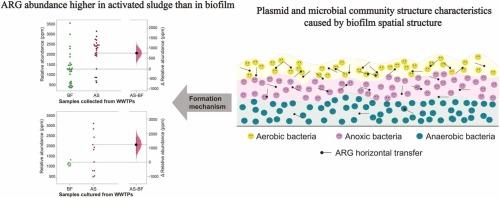污水处理厂活性污泥和生物膜中抗生素耐药基因的差异分析
IF 11.3
1区 环境科学与生态学
Q1 ENGINEERING, ENVIRONMENTAL
引用次数: 0
摘要
污水处理厂是天然水体中抗生素抗性基因(ARGs)的重要来源,活性污泥和生物膜是污水处理厂中最关键的两个生物处理过程。系统地比较这两种工艺中的ARG组成对于优化废水处理系统的设计和运行至关重要。本研究收集了16个污水处理厂的样本,包括一个全规模设施一年的纵向监测数据,包括五种生物膜类型。高通量测序结果显示,活性污泥中ARGs的相对丰度显著高于生物膜,平均相对丰度分别为2075.05 ppm和1288.78 ppm。我们还确定了质粒和微生物群落结构是导致活性污泥和生物膜之间ARG组成差异的关键因素。质粒对ARGs的影响主要与酶修饰机制有关,而微生物群落结构主要影响ARGs的丰度,特别是通过其对拟杆菌的影响。这种结构影响在与酶失活、酶修饰、外排泵、靶标修饰和靶标保护机制相关的ARGs中尤为明显。这些发现为改善污水处理厂中ARG的管理提供了有价值的见解,并有助于制定减轻废水处理系统中ARG扩散的策略。本文章由计算机程序翻译,如有差异,请以英文原文为准。

Differential profiles of antibiotic resistance genes in activated sludge and biofilm in wastewater treatment plants
Wastewater treatment plants (WWTPs) serve as significant sources of antibiotic resistance genes (ARGs) in natural water bodies, with activated sludge and biofilm being the two most critical biological treatment processes in WWTPs. A systematic comparison of ARG composition in these two processes is essential for optimizing the design and operation of wastewater treatment systems. This study collected samples from 16 WWTPs, including one year of longitudinal monitoring data from a full-scale facility and encompassing five biofilm types. The high-throughput sequencing results revealed that the relative abundance of ARGs in activated sludge was significantly higher than in biofilms, with average relative abundances of 2075.05 ppm and 1288.78 ppm, respectively. We also identified plasmids and microbial community structure as key factors contributing to the differences in ARG composition between activated sludge and biofilm. Plasmids primarily influenced the ARGs associated with enzymatic modification mechanisms, while the microbial community structure mainly impacted the abundance of ARGs, particularly through its effect on Bacteroidia. This structural influence was particularly pronounced on ARGs related to enzymatic inactivation, enzymatic modification, efflux pumps, target modification, and target protection mechanisms. These findings provide valuable insights for improving the management of ARGs in WWTPs and contribute to the development of strategies for mitigating ARG proliferation in wastewater treatment systems.
求助全文
通过发布文献求助,成功后即可免费获取论文全文。
去求助
来源期刊

Journal of Hazardous Materials
工程技术-工程:环境
CiteScore
25.40
自引率
5.90%
发文量
3059
审稿时长
58 days
期刊介绍:
The Journal of Hazardous Materials serves as a global platform for promoting cutting-edge research in the field of Environmental Science and Engineering. Our publication features a wide range of articles, including full-length research papers, review articles, and perspectives, with the aim of enhancing our understanding of the dangers and risks associated with various materials concerning public health and the environment. It is important to note that the term "environmental contaminants" refers specifically to substances that pose hazardous effects through contamination, while excluding those that do not have such impacts on the environment or human health. Moreover, we emphasize the distinction between wastes and hazardous materials in order to provide further clarity on the scope of the journal. We have a keen interest in exploring specific compounds and microbial agents that have adverse effects on the environment.
 求助内容:
求助内容: 应助结果提醒方式:
应助结果提醒方式:


